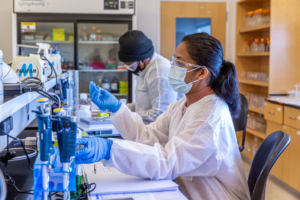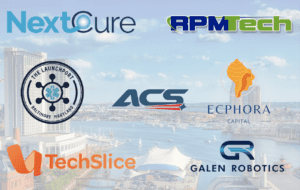
Building Toward a More Sustainable Future – Insights and Tips for Life Science Companies
With climate change continuing to be a significant and growing concern, sustainability is top of mind for many companies. The life sciences industry is no exception.
But working toward a “net-zero” future is easier said than done, with many companies not knowing exactly where or how to start. And in the whirlwind of new regulations and policies, it can be challenging to know the best ways to decrease environmental impact while still being able to fill demanding R&D, manufacturing, and warehouse needs.
The 2022 ISPE MAST Showcase, hosted at the Turf Valley Resort in Ellicott City, Maryland, held an educational session titled “Sustainability Solution for Tomorrow,” where an esteemed panel of project professionals, corporate real estate directors, and innovators discussed progress, challenges, and potential solutions that life sciences companies can implement to have a lighter ecological footprint.
Panelists included:
- John Wasp, Sustainability Leader at Heffron Company
- Timothy Powers, Solar Development & Policy Manager at Inovateus Solar
- Marco De Zan, Project Professional at Farnsworth Group
- Andy Campbell, Senior Manager, Corporate Real Estate at United Therapeutics
- Jessie Fisher, Principal at WB Engineers+Consultants
Below we recap a few of the key takeaways from the discussion.
1) Communication is a Key to Success, but Communication Alone Doesn’t Cut It
The session began with a series of audience polls, quizzing attendees on their knowledge of current Montgomery County, MD policies and sustainability goals within their own organizations.
As panelists reviewed the responses, it was clear that communication was a big gap. The majority of the audience, for example, was not familiar with the Building Energy Performance Standards in Montgomery County, which outline mandatory benchmarks that building owners must hit every year. And in a different question, the majority of responders were not sure whether their company had formalized sustainability goals.
While there is a clear need for local governments to better communicate current standards and policies, there are also many things that should be done at the company level to help bridge this gap.
Whether you’re working to reduce the footprint of an existing building or are working to incorporate sustainability in a new construction, these projects require a lot of time, planning, and effort, and often involve implementing new technology that personnel may not be familiar with. Often, building personal and key managers are given a brief training session around these efforts and are let loose—information and knowledge are typically not retained because they are not reinforced. That, combined with company turnover, is a major hurdle for adaptation.
The panel had a few suggestions for how to make sustainability efforts stick among personnel, all revolving around the common theme of giving employees a sense of ownership in hitting sustainability goals. For example, floors or departments could hold a monthly competition to incentivize hitting benchmarks, or leadership could have frequent communications with the company to make sure everyone is up to speed on the latest guidances and technologies.
Another unique idea came from Andy Campbell of United Therapeutics, who noted how the company created an interactive display to help drive home the importance of United Therapeutics’ efforts. The display has different knobs and buttons that employees can play with first-hand to see how different weather conditions can have an impact on energy efficiency within the building.
2) Now is the Time to Create and Work Toward Sustainability Goals
The majority of the United States electricity grid, which is estimated to have a useful life of ~50 years, was built in the 1950’s and 1960’s. Change is long past due, especially given the fragility of our current grid.
In September 2020, FERC approved Order 2222, which was a major gamechanger in the energy market. The order ruled that Distributed Energy Resources (DERs), which are any entity producing energy that’s not a large-scale powerplant, can now enter the wholesale market and compete alongside traditional sources. DERs include power generation or storage technologies such as solar energy, electric vehicles and their charging equipment, wind energy, etc. The order will help provide a variety of benefits including lower costs for consumers through enhanced competition, less load on the grid, and more innovation within the electric power industry—all things that will help persuade the life science industry to take the initiative toward a greener future.
The bar is also being set at the corporate level as well. For example, there are many more activist investors who pay close attention to ESG scores, setting a standard for how companies should behave if they want to receive funding. The Millenial and Gen Z workforce is also deeply engrained in sustainability and are paying attention to what companies are doing to combat climate change.
3) Go After the Low Hanging Fruit, and Don’t Let Perfect be the Enemy of Good
The idea of being a completely net-zero company can be daunting, especially when the definition of net-zero means different things to different people. And when the production and quality of potentially life-saving medicines are on the line, many are hesitant to expend extra time, capital, resources, and challenges when they could keep with standard procedures that they know work.
The panelists emphasized the importance of even just taking small baby steps towards making a more sustainable facility, as caring for the health of the Earth is crucial to ensure the health of our people. Something as simple as changing out existing lightbulbs for LEDs can have an immediate impact on increasing efficiency, lowering electric bills, and reducing grid load. Making small changes is also a much more obtainable goal for smaller biotechs who might not yet have the budget to afford solar panels or other solutions.
Planning is also vital. While it might be tempting to go all-in on solar panels, it usually makes more sense to go after the low-hanging fruit first. This way, companies can evaluate what their new energy load is before they commit to solar, meaning they will likely be spending less in the long run. Facilities personnel should also resist the temptation to immediately swap out equipment, but rather create a plan in advance to switch to greener options once the piece of equipment is toward the end of its lifespan or has an issue that warrants a replacement. No need to contribute unnecessarily to landfills.
4) Sustainability is Hard – Don’t Go at it Alone
Navigating this new realm is challenging, especially as new rules and regulations are being passed. How do I know if I’m in compliance? Could I be doing more? How do I even get started? This is especially true for smaller companies, where capital must be carefully spent.
Perhaps one of the biggest pieces of advice from the panel is to get to know your region’s local economic development professionals, as they will know what resources are out there to help companies offset costs. Energy companies such as PEPCO and BGE also have programs to audit a facility and help to offset costs.
- About the Author
- Latest Posts
Sarah Ellinwood is BioBuzz’s Managing Editor. A scientist by training and a science communicator at heart, Sarah specializes in making complex concepts understandable, engaging, and exciting. She received her Ph.D. in molecular and cellular biology with a focus in infectious disease immunology from the University of Maryland and is passionate about all things related to scicomm, peer mentorship, and women in STEM.






